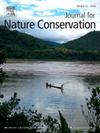Biodiversity between volcanoes: A multi-taxa analysis to identify priority conservation areas in a highly fragmented landscape of the Trans-Mexican Volcanic Belt
IF 2.2
3区 环境科学与生态学
Q2 BIODIVERSITY CONSERVATION
引用次数: 0
Abstract
The effectiveness of protected areas (PAs) for conservation is under debate because many were decreed without considering biological criteria. Efforts have been made to increase their numbers and to promote ecological connectivity among the existing PAs. In this study, we identify new priority conservation areas (PCAs) through a multi-taxa analysis in a highly fragmented landscape between La Malinche (LMNP) and Iztaccíhuatl − Popocatépetl (IPNP) National Parks in the Trans-Mexican Volcanic Belt. Particularly, we compared the taxonomic diversity of amphibians, reptiles, terrestrial mammals, scarab beetles, myxomycetes, and soil fungal species in six polygons with different land uses and vegetation types. We paid attention to the taxonomic diversity patterns according to the disturbance tolerance of the species, and we described the relationship between biodiversity and environmental variables. Adjacent temperate forests of the IPNP are habitats for the greatest number of species and individuals with low tolerance to disturbance. Polygons located in the central hills of Tlaxcala serve as a reservoir of mainly generalist species but also host exclusive and low tolerance species even though ∼ 63 % of the original vegetation has been transformed. Restoration and conservation through Areas Voluntarily Destined for Conservation and communal protected areas is a challenge that must be addressed to promote biological connectivity between the studied National Parks. Finally, we suggest that multi-taxonomic approaches discriminating species by their level of disturbance tolerance could be an efficient tool to identify new PCAs that ensure ecological processes and maintain diverse communities in highly fragmented landscapes.
求助全文
约1分钟内获得全文
求助全文
来源期刊

Journal for Nature Conservation
环境科学-生态学
CiteScore
3.70
自引率
5.00%
发文量
151
审稿时长
7.9 weeks
期刊介绍:
The Journal for Nature Conservation addresses concepts, methods and techniques for nature conservation. This international and interdisciplinary journal encourages collaboration between scientists and practitioners, including the integration of biodiversity issues with social and economic concepts. Therefore, conceptual, technical and methodological papers, as well as reviews, research papers, and short communications are welcomed from a wide range of disciplines, including theoretical ecology, landscape ecology, restoration ecology, ecological modelling, and others, provided that there is a clear connection and immediate relevance to nature conservation.
Manuscripts without any immediate conservation context, such as inventories, distribution modelling, genetic studies, animal behaviour, plant physiology, will not be considered for this journal; though such data may be useful for conservationists and managers in the future, this is outside of the current scope of the journal.
 求助内容:
求助内容: 应助结果提醒方式:
应助结果提醒方式:


